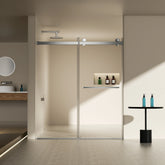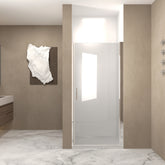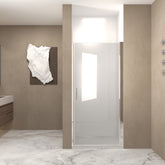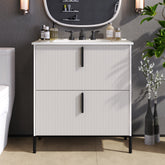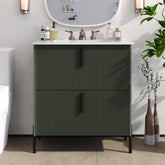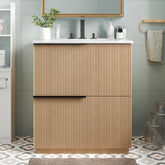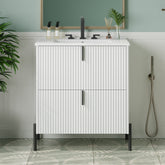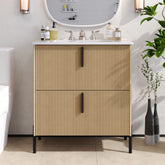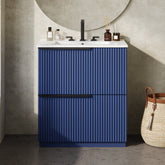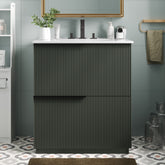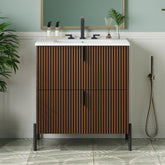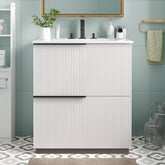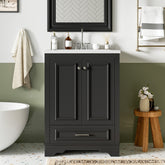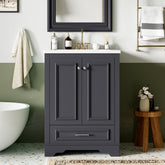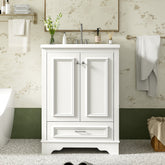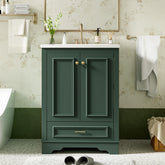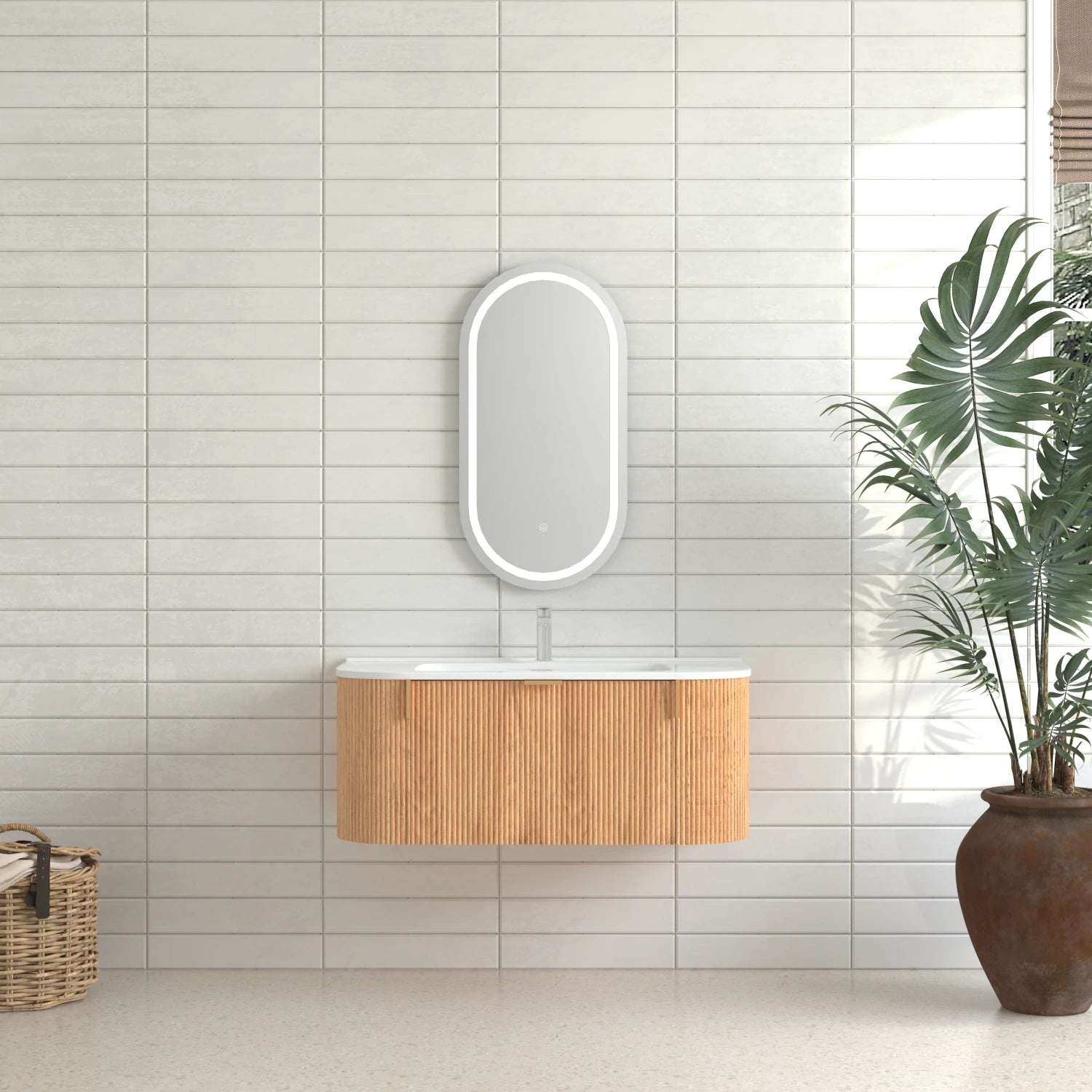The Rise of Japandi Style in Bathroom Design
1. Introduction
A New Era in Bathroom Design
Over the years, I've watched bathroom design evolve from purely functional spaces to personal sanctuaries that reflect our lifestyles, values, and taste. Trends come and go, but one movement has quietly and confidently taken center stage: Japandi bathroom design. It speaks to something deeper than surface beauty — a desire for calm, clarity, and connection with nature in our daily routines.
What Is Japandi Style?
At its core, Japandi is a seamless blend of two timeless aesthetics — Japanese minimalism and Scandinavian functionality. Think of it as the best of both worlds: the serene, Zen-inspired atmosphere of Japanese interiors combined with the cozy simplicity and practicality found in Scandinavian design. The result? A bathroom that feels like a quiet retreat, marked by clean lines, natural materials, and a neutral color palette that soothes the senses.
Whether you're redesigning a large master bathroom or refreshing a compact guest space, embracing the Japandi style bathroom design opens the door to a refined and grounded approach. In the sections that follow, I'll walk you through why this trend is rising, how to achieve the look, and why I believe Japandi isn’t just a passing style — it's a philosophy for modern living.
2. What is Japandi Style?
The Origins and Philosophy Behind Japandi
When I first discovered Japandi interior design, it immediately resonated with me. This unique style is a harmonious fusion of two cultures that, while geographically distant, share a deep respect for simplicity, purpose, and nature. On one side, there's the Japanese concept of wabi-sabi, which embraces imperfection and transience. On the other, Scandinavian design brings in the cozy and functional charm known as hygge. Together, they form what we now call Japandi style—a design philosophy that promotes mindful living and intentional spaces.
Core Elements of Japandi Bathroom Design
In a Japandi style bathroom, every element has a role to play. I’ve found that the beauty of this aesthetic lies in its commitment to less being more. Clean lines, unfussy layouts, and clutter-free surfaces define the space. The natural materials—like light-toned woods, stone, bamboo, and organic fabrics—bring warmth and texture without overwhelming the senses. Functionality isn’t sacrificed for beauty; in fact, it’s celebrated. Every feature, from floating vanities to built-in storage, is designed with purpose.
The color palette is another key element. I gravitate toward neutral tones—soft whites, earthy beiges, charcoal greys, and muted greens—which help create a calming, grounded atmosphere. These hues not only make the space feel larger and more open but also contribute to a peaceful, almost meditative mood. Whether I'm designing for a spacious ensuite or a small powder room, these shades help transform the bathroom into a sanctuary.
More Than Just a Style—It’s a Feeling
What truly sets Japandi apart is the feeling it evokes. It’s not just about having a minimalist bathroom or using trending materials—it's about how the space makes you feel. When I step into a Japandi-style bathroom, I feel an instant sense of calm and clarity. There’s a quiet elegance to the simplicity. No clutter, no chaos—just intentional design that supports a peaceful lifestyle.
For anyone seeking a design direction that combines functionality with a sense of zen, Japandi bathroom ideas offer a compelling answer. In the next section, I’ll share why this style is rapidly gaining popularity and how it aligns with modern living.
3. Why Japandi is Rising in Popularity for Bathrooms
The Desire for Serenity at Home
These days, more people—including myself—are craving a sense of calm in their homes, and nowhere is that more important than in the bathroom. It's no longer just a place to get ready; it’s where I go to unwind, recharge, and disconnect from the chaos of daily life. That’s why Japandi bathroom design has become so appealing. With its minimalist layout, soft textures, and neutral tones, it creates a serene, spa-like atmosphere that many of us desperately need.
A Shift Toward Sustainability
Another reason I believe the Japandi style bathroom is gaining traction is its alignment with sustainable living. The style naturally favors natural materials—like wood, stone, and cotton—that are not only beautiful but also eco-conscious. People are more mindful of their environmental impact than ever, and Japandi speaks directly to that sensibility. I’ve seen more clients request spaces that feel organic and grounded, and Japandi effortlessly meets that demand.
Inspired by Design Blogs and Social Media
Let’s face it—we’re all influenced by what we see online. Lately, my feed has been flooded with Japandi bathroom ideas that blend aesthetics and comfort in the most effortless way. Design influencers, Pinterest boards, and interior blogs have brought Japandi into the spotlight, making it more accessible and aspirational. The clean visuals, paired with that sense of tranquility, are a winning combination that captures attention and sparks inspiration.
The Post-Pandemic Wellness Movement
Since the pandemic, our relationship with home has fundamentally changed. I’ve noticed a growing demand for spaces that support mental well-being and encourage mindfulness. Bathrooms, once overlooked, are now seen as personal wellness retreats. The Japandi interior design philosophy—focused on simplicity, balance, and emotional comfort—aligns perfectly with this shift. It's more than just a trend; it’s a response to the world around us.
All of these factors—our need for peace, our focus on sustainability, and the influence of digital media—are pushing the Japandi style to the forefront of modern bathroom design trends. In the next section, I’ll dive into the specific design elements that make a Japandi bathroom truly stand out.
4. Key Design Elements of a Japandi Bathroom
Calming, Neutral Color Palette
One of the first things I focus on when designing a Japandi style bathroom is the color scheme. Soft neutrals like off-whites, beige, and warm grays create a soothing foundation. I love adding earthy tones—think muted greens or sandy taupes—for a grounded, nature-inspired feel. These Japandi bathroom color palettes help evoke a calm, serene atmosphere and make the space feel larger, lighter, and more open.
Natural and Sustainable Materials
For me, the materials are where Japandi truly shines. I always lean toward natural textures like light-toned wood for vanities or shelving, and stone for countertops or accents. Bamboo works beautifully for accessories, adding an organic warmth. To give the space a modern edge, I like to incorporate matte black fixtures—they offer clean contrast without overpowering the minimal look. Choosing these kinds of sustainable bathroom materials not only adds style but also supports a more eco-friendly lifestyle.
Thoughtfully Designed Fixtures and Furniture
When selecting furniture and fixtures for a Japandi bathroom design, I prioritize simplicity and function. A floating vanity is one of my go-to choices—it creates the illusion of space and keeps the room looking clean and uncluttered. Pair that with a vessel sink and a frameless mirror, and you have a sleek setup that feels both modern and timeless. Every piece should feel intentional, with no unnecessary embellishments.
Open Layout and Minimal Clutter
Japandi isn’t just a visual style—it’s a spatial experience. I like to keep the bathroom layout as open and breathable as possible. Smart storage solutions help keep the surfaces clear and allow the beauty of the materials and textures to stand out. A clutter-free bathroom isn't just easier to maintain—it also feels lighter and more peaceful to be in. That’s what Japandi is all about.
Soft and Natural Lighting
Lighting plays a big role in setting the mood. I always aim for soft, indirect lighting—wall sconces with warm tones, hidden LED strips under the vanity, or pendant lights over the sink. When possible, I maximize natural light with large windows, frosted glass, or skylights. The goal is to create a space that feels fresh in the morning and relaxing in the evening.
These design elements work together to form the heart of Japandi bathroom design. In the next section, I’ll walk you through how to bring this look into your own home, whether you’re planning a full renovation or just making a few thoughtful updates.
5. How to Achieve the Japandi Look in Your Bathroom
Start with the Essentials
When I begin transforming a space into a Japandi bathroom, I always focus on the core elements first. That means rethinking the layout, simplifying the palette, and choosing furniture with clean, minimal lines. If you're remodeling, consider installing a floating vanity in natural wood or matte finishes—it instantly gives the bathroom that sleek yet warm feel. Even if you’re just upgrading, swapping out key pieces like the vanity or mirror can dramatically shift the tone of the entire space.
Choose the Right Japandi-Inspired Products
Over the years, I’ve found a few go-to items that really bring the Japandi bathroom design to life. Here are some of my favorites:
- Vanities: Wall-mounted wood vanities in oak or walnut with smooth, flat-panel drawers.
- Mirrors: Frameless or subtly framed mirrors in organic shapes—great for softening the overall look.
- Lighting: Minimal pendant lights, LED backlit mirrors, or simple sconces with a warm glow.
- Accessories: Bamboo trays, ceramic soap dispensers, woven baskets, and soft cotton towels in muted tones.
With these choices, you can create a harmonious, spa-like environment that feels both modern and timeless.
Stay Consistent with Materials and Textures
One common mistake I see people make when trying to achieve the Japandi style bathroom is mixing too many textures or tones. The beauty of Japandi lies in restraint. Stick to a balanced mix of materials—wood, stone, and metal—and choose a unified Japandi color palette with soft, neutral tones. This helps avoid visual clutter and maintains the calm, cohesive vibe that defines the style.
Avoid Overdecorating
Another pitfall is adding too many decorative items. In Japandi, less is truly more. Every object should serve a purpose, whether it’s functional or emotional. I recommend keeping surfaces clear and only displaying a few curated pieces, like a small plant, a ceramic dish, or a textured towel. Let the simplicity speak for itself.
Bring in Nature
Don’t forget to incorporate natural elements wherever possible. I like placing a small bonsai, pampas grass in a ceramic vase, or even a wooden stool in the corner. These subtle touches connect the space to nature and enhance that grounded, tranquil feeling we all crave in a Japandi bathroom interior.
With a bit of planning and a focus on simplicity, you can bring the calm elegance of Japandi into your bathroom. In the final section, I’ll share my thoughts on why this style isn’t just a trend—but a lasting approach to wellness-focused design.
6. Japandi Style in Small Bathrooms
Less Space, More Intention
One of the things I love most about Japandi bathroom design is how well it works in small spaces. In fact, I think Japandi truly shines when applied to compact bathrooms. The core principles—simplicity, functionality, and minimalism—are exactly what a small space needs to feel more open and breathable.
Embrace Wall-Mounted Fixtures
In small bathrooms, every inch matters. That’s why I always recommend wall-mounted vanities and toilets. Floating vanities not only free up floor space but also make the room look lighter and less cluttered. Pair that with a frameless mirror to reflect light and visually expand the area—it’s a subtle trick that really works.
Think Vertical
Vertical storage is a game-changer in Japandi-inspired small bathrooms. I like to use tall, narrow shelving units or install floating wood shelves above the toilet or next to the vanity. This helps keep surfaces clear and essentials within reach without overwhelming the space. Just remember to keep the shelves styled with restraint—only a few Japandi bathroom accessories, like a folded towel, a ceramic jar, or a tiny potted plant.
Stick to a Unified Color and Material Palette
In smaller spaces, cohesion is key. I make sure to stick to a tight Japandi color palette—soft whites, muted taupe, and natural wood tones—to prevent the room from feeling busy or disjointed. For materials, using the same tone of wood across the vanity, shelves, and accents helps tie everything together, creating a more serene and spacious effect.
Clean Lines, Open Feel
I always aim for clean lines and low-profile fixtures in compact Japandi bathrooms. Whether it’s a minimal faucet, a slim pendant light, or flat-front cabinetry, the goal is to keep visual noise to a minimum. Every design choice should support the open, breathable feel that defines the Japandi bathroom interior.
Just because a bathroom is small doesn’t mean it can’t feel luxurious. With thoughtful planning and a focus on essentials, Japandi brings calm and clarity into even the coziest of spaces.
7. Future Outlook: Is Japandi Here to Stay?
A Style That Transcends Trends
As someone deeply passionate about interior design, I’ve seen countless styles come and go. But the Japandi style bathroom feels different. It’s not just another fleeting aesthetic—it taps into deeper values like mindfulness, simplicity, and intentional living. These principles resonate more than ever, especially as people seek wellness and tranquility within their homes.
In Harmony with Long-Term Design Trends
I believe Japandi bathroom design aligns perfectly with the growing shift toward timeless design and sustainable living. Its focus on natural materials like wood, stone, and bamboo not only adds warmth but also supports eco-friendly choices. The popularity of soft neutrals and clean lines reflects a broader move away from excessive ornamentation toward more grounded, thoughtful spaces.
Architectural Influence and Longevity
We’re already seeing Japandi principles influence larger architectural decisions—open layouts, minimal partitioning, and strategic use of natural light are becoming staples in new builds and remodels. In bathrooms specifically, the continued use of floating vanities, frameless mirrors, and matte fixtures suggests that the Japandi bathroom interior is not just a passing phase but part of a lasting design movement.
Wellness, Sustainability, and Simplicity
What keeps me optimistic about the future of Japandi is its deep connection to wellness. After the pandemic, people are placing more emphasis on self-care and home comfort. The Japandi bathroom—with its calming palette, uncluttered design, and spa-like ambiance—meets this need perfectly. Combine that with its alignment to sustainable design practices, and you have a style built not just for now, but for what’s next.
In my view, Japandi isn’t just a trend—it’s a design philosophy with staying power. As we continue to prioritize mindful living and environmentally conscious choices, I expect to see even more Japandi-inspired bathrooms appearing in homes around the world.
8. Conclusion
More Than a Trend—A Lifestyle Shift
After exploring the essence of Japandi bathroom design, I’ve come to appreciate just how much more this style offers beyond aesthetics. It’s not just about soft neutrals, floating vanities, or minimalist decor—though those elements certainly help define the look. Japandi is a reflection of a lifestyle that values calm, clarity, and intentional living. In a world full of noise and visual clutter, this design philosophy brings peace and purpose to our most personal spaces.
A Timeless Choice for Modern Living
Whether you're remodeling a large master bath or upgrading a compact guest space, the Japandi bathroom interior delivers a timeless elegance that adapts effortlessly to modern life. Its use of natural materials, commitment to functionality, and emphasis on sustainability make it a meaningful choice for today—and tomorrow.
Find Calm in Everyday Moments
If you’re seeking a bathroom design that’s both beautiful and practical, that nurtures serenity without sacrificing style, I encourage you to consider Japandi. For me, it’s become more than a design trend—it’s a way to reconnect with the simple things, create a daily retreat, and bring a sense of balance into my home.
Ultimately, the rise of the Japandi style bathroom signals a shift toward more mindful living—and I believe it’s a movement that’s here to stay.
Featured Products
AISU 30" Fluted Design Freestanding Bathroom Vanity with Ceramic Sink, Gray
- $416.74
- $416.74
- Unit price
- / per
AISU 30" Ultra Fluted Design Freestanding Bathroom Vanity with Ceramic Sink, With Leg, White
- $428.50
- $428.50
- Unit price
- / per
AISU 30" Fluted Design Freestanding Bathroom Vanity with Ceramic Sink, White
- $416.74
- $416.74
- Unit price
- / per
AISU 30" Ultra Fluted Design Freestanding Bathroom Vanity with Ceramic Sink, With Leg, Green
- $428.50
- $428.50
- Unit price
- / per
AISU 30" Fluted Design Freestanding Bathroom Vanity with Ceramic Sink, Wood
- $432.41
- $432.41
- Unit price
- / per
AISU 30" Fluted Design Freestanding Bathroom Vanity with Ceramic Sink, With Leg, White
- $413.40
- $413.40
- Unit price
- / per
AISU 30" Ultra Fluted Design Freestanding Bathroom Vanity with Ceramic Sink, With Leg, Wood
- $428.50
- $428.50
- Unit price
- / per
AISU 30" Fluted Design Freestanding Bathroom Vanity with Ceramic Sink, Blue
- $416.74
- $416.74
- Unit price
- / per
AISU 30" Ultra Fluted Design Freestanding Bathroom Vanity with Ceramic Sink, Green
- $432.41
- $432.41
- Unit price
- / per
AISU 30" Fluted Design Freestanding Bathroom Vanity with Ceramic Sink, With Leg, Dark Brown
- $413.40
- $413.40
- Unit price
- / per
AISU 30" Ultra Fluted Design Freestanding Bathroom Vanity with Ceramic Sink, White
- $432.41
- $432.41
- Unit price
- / per
AISU 24" Modern Freestanding Bathroom Vanity with Ceramic Sink, Black
- $333.30
- $333.30
- Unit price
- / per
AISU 24" Modern Freestanding Bathroom Vanity with Ceramic Sink, Dark Grey
- $333.30
- $333.30
- Unit price
- / per
AISU 24" Modern Freestanding Bathroom Vanity with Ceramic Sink, White
- $333.30
- $333.30
- Unit price
- / per
AISU 24" Modern Freestanding Bathroom Vanity with Ceramic Sink, Green
- $333.30
- $333.30
- Unit price
- / per
